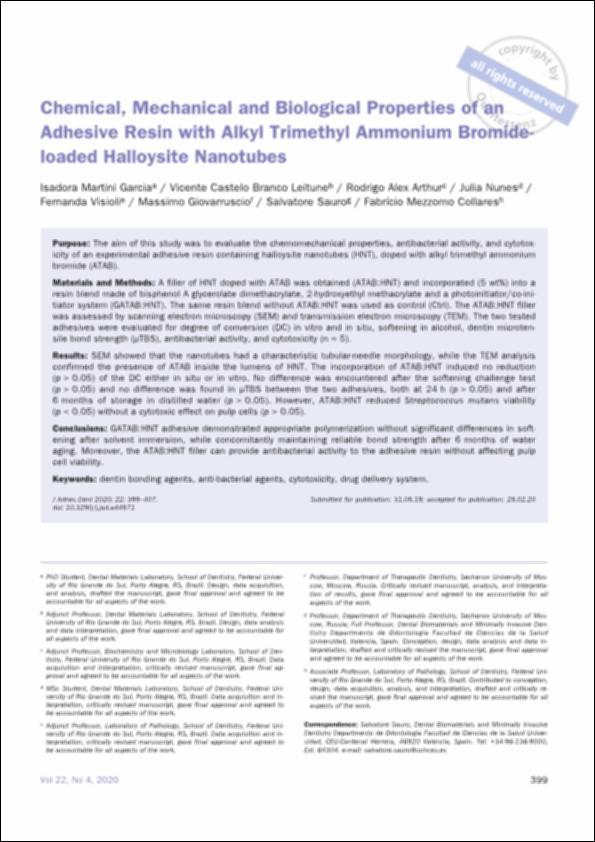Please use this identifier to cite or link to this item:
http://hdl.handle.net/10637/13217Chemical, mechanical and biological properties of an adhesive resin with alkyl trimethyl ammonium bromide-loaded halloysite nanotubes
| Title: | Chemical, mechanical and biological properties of an adhesive resin with alkyl trimethyl ammonium bromide-loaded halloysite nanotubes |
| Authors : | Garcia, Isadora Martini Leitune, Vicente Castelo Branco Arthur, Rodrigo Alex Nunes, Julia Visioli, Fernanda Giovarruscio, Massimo Sauro, Salvatore. Collares, Fabrício M. |
| Keywords: | Gums and resins in Dentistry.; Medicamentos - Administración.; Drugs - Administration.; Germicides.; Adhesivos dentales.; Dental adhesives.; Bactericidas.; Gomas y resinas - Aplicaciones en Odontología. |
| Publisher: | Quintessenz. |
| Citation: | Garcia, I.M., Leitune, V.C.B., Arthur, R.A., Nunes, J., Visioli, F., Giovarruscio, M., Sauro, S. & Collares, F.M. (2020). Chemical, mechanical and biological properties of an adhesive resin with alkyl trimethyl ammonium bromide-loaded halloysite nanotubes. The Journal of Adhesive Dentistry, vol. 22, n. 4 (27 jul.), pp. 399-407. DOI: https://doi.org/10.3290/j.jad.a44871 |
| Abstract: | Purpose: The aim of this study was to evaluate the chemomechanical properties, antibacterial activity, and cytotoxicity of an experimental adhesive resin containing halloysite nanotubes (HNT), doped with alkyl trimethyl ammonium bromide (ATAB). Materials and Methods: A filler of HNT doped with ATAB was obtained (ATAB:HNT) and incorporated (5 wt%) into a resin blend made of bisphenol A glycerolate dimethacrylate, 2-hydroxyethyl methacrylate and a photoinitiator/co-initiator system (GATAB:HNT). The same resin blend without ATAB:HNT was used as control (Ctrl). The ATAB:HNT filler was assessed by scanning electron microscopy (SEM) and transmission electron microscopy (TEM). The two tested adhesives were evaluated for degree of conversion (DC) in vitro and in situ, softening in alcohol, dentin microtensile bond strength (μTBS), antibacterial activity, and cytotoxicity (n = 5). Results: SEM showed that the nanotubes had a characteristic tubular-needle morphology, while the TEM analysis confirmed the presence of ATAB inside the lumens of HNT. The incorporation of ATAB:HNT induced no reduction (p > 0.05) of the DC either in situ or in vitro. No difference was encountered after the softening challenge test (p > 0.05) and no difference was found in μTBS between the two adhesives, both at 24 h (p > 0.05) and after 6 months of storage in distilled water (p > 0.05). However, ATAB:HNT reduced Streptococcus mutans viability (p < 0.05) without a cytotoxic effect on pulp cells (p > 0.05). Conclusions: GATAB:HNT adhesive demonstrated appropriate polymerization without significant differences in softening after solvent immersion, while concomitantly maintaining reliable bond strength after 6 months of water aging. Moreover, the ATAB:HNT filler can provide antibacterial activity to the adhesive resin without affecting pulp cell viability. |
| Description: | Este artículo se encuentra disponible en la siguiente URL: https://www.quintessence-publishing.com/deu/en/article/843551 |
| URI: | http://hdl.handle.net/10637/13217 |
| Rights : | http://creativecommons.org/licenses/by-nc-nd/4.0/deed.es |
| ISSN: | 1461-5185. 1757-9988 (Electrónico) |
| Issue Date: | 27-Jul-2020 |
| Center : | Universidad Cardenal Herrera-CEU |
| Appears in Collections: | Dpto. Odontología |
Items in DSpace are protected by copyright, with all rights reserved, unless otherwise indicated.


